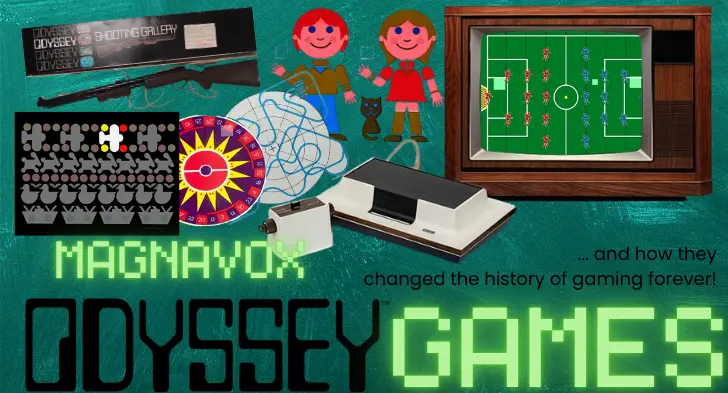Introduction: A New Era of Gaming Begins
When Ralph H. Baer introduced the Magnavox Odyssey in 1972, he ushered in a completely new era of entertainment—the home video game console. This device predated the Atari 2600 and all other gaming systems, making it the world’s first video game console. But unlike today’s machines, Odyssey’s games weren’t made of complex graphics or soundtracks. Instead, they were built on innovation, overlays, and imagination. The library of Magnavox Odyssey games is unlike anything else in gaming history, and despite their primitive form, they laid the foundation for modern gaming.
In this article, we’ll explore the fascinating world of Odyssey games—from how they worked, their unique titles and accessories, to how you can still play them through emulators in 2025.
How Magnavox Odyssey Games Worked
Unlike modern consoles that use chips, graphics, and memory cards, Odyssey games functioned in a remarkably simple yet ingenious way. Here’s what made them unique:
- Cartridges as Circuit Boards: Instead of storing code, Odyssey cartridges acted as jumpers that rewired the console’s circuits to create different behaviors on-screen.
- No Graphics, Just White Dots: The console displayed only a few white squares or lines on the TV. The rest of the visual “game world” was created with plastic overlays placed directly on the television screen.
- Overlays: These colorful plastic sheets simulated environments—tennis courts, haunted houses, ski slopes—and provided the imagination fuel for players.
- Accessories: Many Odyssey games required dice, cards, and score sheets, combining elements of board games with video gaming.
This hybrid approach made the Odyssey a bridge between analog and digital play, unlike anything that came before or after.
Major Magnavox Odyssey Games
The Odyssey launched with a library of 28 games, all released between 1972 and 1973. Below are some of the most significant titles:
Table Tennis

Often considered the most famous Odyssey game, Table Tennis showcased the console’s simplicity while highlighting its groundbreaking innovation for the early 1970s. The game used two paddles controlled by the players and a single bouncing dot to represent the ball. To make the experience feel more immersive, players placed a transparent plastic overlay on their TV screen that resembled a green table with a net drawn in the middle. Since the Odyssey had no built-in sound or advanced graphics, the overlays were essential in bringing the game to life and adding context to what was otherwise just a white dot moving across a black background.
The gameplay itself was straightforward but addictive: players had to “hit” the ball back and forth, trying to outmaneuver their opponent. What made Table Tennis so significant was not just its popularity among Odyssey owners but also its influence on the gaming industry. The concept directly inspired Atari’s Pong, which refined the mechanics, added scoring, and introduced sound effects, becoming one of the first arcade hits in history.
In retrospect, Table Tennis is more than just a simple game; it represents the spark that ignited the commercial video game industry. While it lacked the polish and widespread accessibility of Pong, it laid the foundation for competitive two-player gaming and demonstrated the potential of interactive entertainment on home television screens.
Ski

Ski was another standout title for the Magnavox Odyssey, showing just how versatile the console could be despite its extremely limited hardware. Using a snowy slope overlay placed on the TV screen, the game transformed a simple dot into a skier racing down a mountain. Players tilted and turned their paddles to guide the skier, attempting to weave around imaginary obstacles like trees and rocks. While the Odyssey couldn’t display these hazards graphically, players relied on the overlay and their imagination to fill in the gaps, which was part of the charm of the system.
The goal was to make it down the slope as quickly as possible, often competing against another player’s time to see who could manage the cleanest and fastest run. In practice, this introduced a thrilling mix of speed, precision, and control, all of which felt fresh for a home console game in the early 1970s.
What makes Ski interesting in hindsight is how it prefigured the racing and sports genres that would later become staples in gaming. It encouraged players to not just react to their opponent but to focus on their own performance, bringing in a sense of competition against time itself—an early example of what would evolve into the popular “time trial” mode seen in countless racing and sports games today.
Submarine

Submarine turned the Odyssey into a naval battlefield, showcasing the system’s ability to deliver competitive, head-to-head gameplay. One player controlled a dot representing a submarine moving stealthily across the screen, while the other commanded a destroyer trying to sink it by firing torpedoes. To enhance the illusion, players placed a colorful overlay of an underwater seascape on the television, transforming the plain black screen into an ocean filled with depth and danger.
The match became a tense contest of strategy and timing. The submarine player had to maneuver carefully, dodging incoming fire while staying within the boundaries of the ocean overlay. Meanwhile, the torpedo player had to anticipate the submarine’s movements and line up precise shots, creating a cat-and-mouse style of gameplay.
What made Submarine notable is how it hinted at the tactical and asymmetrical gameplay that would later become popular in video games. Unlike many Odyssey titles where both players had identical roles, Submarine forced each participant to think differently: one focused on evasion and survival, the other on aiming and attack. This dual perspective made the game stand out among the Odyssey’s library and foreshadowed the development of competitive multiplayer experiences in later generations.
Haunted House

Haunted House was one of the most imaginative titles in the Magnavox Odyssey library, blending traditional board game mechanics with video interactivity. Instead of fast reflexes or paddle-based action, players explored a spooky mansion using a translucent overlay that turned the television screen into a haunted estate filled with rooms and passageways. Movement wasn’t controlled directly by the paddles but determined through dice rolls and special strategy cards, making it feel much closer to a hybrid between a video game and a family board game.
The goal was to navigate through the eerie mansion while dealing with unexpected twists introduced by the cards, which could either help or hinder a player’s progress. The video element—the moving dot on the screen—represented a player’s position inside the house, while the overlay and rules provided the story-driven context.
What made Haunted House stand out was how it highlighted the Odyssey’s role as more than just a video game console. It blurred the line between electronic entertainment and traditional tabletop play, offering a unique social experience where imagination was just as important as technology. In many ways, it foreshadowed the later rise of interactive storytelling and hybrid gaming—the kind of creative experiments that would inspire both video games with narrative depth and board games with digital components decades later.
Roulette

Roulette was one of the more unconventional titles for the Magnavox Odyssey, leaning less on arcade-style action and more on social play. The game came with an overlay of a roulette wheel, which transformed the television screen into a casino table. Instead of fast reflexes, the experience revolved around chance and betting, much like the real-world game it was imitating.
Players would place their bets physically, using chips or markers included in the Odyssey game set, before spinning the electronic “ball” represented by a dot on the screen. Once the ball settled into a spot on the wheel, players compared results against their wagers to see who came out on top.
What makes Roulette interesting is how it blurred the line between digital play and traditional tabletop gaming. It wasn’t about graphics or complex controls but about creating a shared, social atmosphere—an attempt by Magnavox to appeal not just to kids but also to adults who might enjoy a casino-style evening at home. In hindsight, Roulette also reflects the Odyssey’s experimental spirit: the console wasn’t confined to a single genre but instead tested how video technology could merge with familiar real-world pastimes.
Simon Says

Simon Says brought the classic children’s game to the Magnavox Odyssey, translating a well-loved playground activity into an early digital format. Just like the traditional version, the focus was on following commands correctly, but instead of a person giving verbal instructions, the Odyssey used its limited screen outputs to guide players. A dot on the screen could represent the leader’s command, while the second player had to mimic or respond according to the established rules.
Because the console lacked sound and complex visuals, much of the fun came from combining on-screen cues with imagination and house rules. Often, the gameplay was supplemented with spoken instructions or prompts from one player acting as the “Simon,” which turned the Odyssey into a shared, family-oriented experience.
What makes Simon Says noteworthy is how it highlighted the Odyssey’s role not just as a video game machine, but as a party and family entertainment system. It blurred the boundaries between digital and traditional play, encouraging creativity and group interaction over flashy graphics or technical complexity. In many ways, it captured the essence of the Odyssey’s design philosophy: simple visuals paired with social, imaginative fun.
Football

Football was one of the most ambitious sports titles on the Magnavox Odyssey, aiming to replicate America’s favorite pastime on a system with extremely limited graphics. Players used a detailed overlay of a football field, which turned the TV screen into a stadium-like setting. The on-screen dots represented players, and with some imagination, the action transformed into running plays, passes, and attempts to score.
The gameplay involved maneuvering the dots strategically to simulate offensive and defensive plays. One player would try to advance down the field, “running” or “passing” by moving the dot across the overlay, while the other defended by intercepting or blocking movements. Since the Odyssey couldn’t handle automated scoring or detailed rules, players kept track of downs, yardage, and points manually—making the game part electronic simulation and part old-fashioned record-keeping.
What makes Football stand out in the Odyssey’s library is its attempt to capture the complexity of a team sport within such a primitive system. It reflected Magnavox’s ambition to create games that appealed to sports fans and families alike, even if much of the action depended on imagination and adherence to house rules. In many ways, it laid the groundwork for the evolution of sports video games, foreshadowing the immersive realism that franchises like Madden NFL would bring decades later.
Shooting Gallery (with Light Gun)

Shooting Gallery was one of the most groundbreaking titles for the Magnavox Odyssey because it introduced something truly ahead of its time: a light gun peripheral. Packaged with a plastic rifle accessory, the game allowed players to aim at the television screen and “shoot” at moving targets represented by dots. To enhance the experience, themed overlays transformed the blank screen into carnival booths, hunting ranges, or wild west shootouts, giving context to what would otherwise be simple targets.
What made Shooting Gallery revolutionary was the technology behind it. The Odyssey rifle didn’t fire projectiles or use sensors in the television—it actually detected the light emitted from the screen when aimed correctly. This made it one of the very first instances of a light gun being used with a home console, a concept that would later inspire classics like Duck Hunt on the NES and countless arcade shooters.
For players in the early 1970s, this was unlike anything they had seen before. The tactile experience of aiming a gun at the TV and getting a reaction from the screen made the Odyssey feel more immersive than almost any other console of its era. It showcased the system’s experimental spirit and set a precedent for how accessories could dramatically expand the scope of home gaming.
These games may look primitive today, but at the time, they offered an entirely new form of entertainment.
Accessories & Special Games

Magnavox Odyssey wasn’t just about the console itself—it was about the whole play experience. Many games depended on accessories:
- The Light Gun Rifle: Used for Shooting Gallery, this was one of the earliest console light gun peripherals.
- Dice and Cards: Games like Haunted House and Roulette required board game-like components to function fully.
- Score Sheets: Players often kept manual records of scores, as the console itself lacked memory.
- Overlays: Essential to nearly every game, they were the Odyssey’s defining feature, transforming white dots into worlds.
These extras blurred the line between physical and digital play, making the Odyssey more of a hybrid entertainment system than a pure video game console.
How to Play Magnavox Odyssey Games on Emulator in 2025
The Odyssey is not the easiest console to emulate due to its unique design, but enthusiasts can still experience its games today. Here’s how:
1. Supported Emulators
- MAME (Multiple Arcade Machine Emulator): MAME has partial support for Odyssey, letting you simulate basic gameplay.
- Odyemu: A dedicated emulator for Odyssey enthusiasts, replicating cartridge behaviors and overlays.
2. Finding Games and Overlays
- ROMs and BIOS Files: Since Odyssey cartridges are essentially circuit switchers, ROMs are small and simple. Enthusiast communities often host recreations.
- Overlays: High-quality scans of Odyssey overlays are widely available online. Many emulators let you layer these digitally for authentic gameplay.
3. Recreating Accessories
- Dice, scorecards, and even the light gun experience are digitally replicated or substituted with software solutions.
4. Challenges of Emulation
- Overlay Accuracy: Since the console relied heavily on overlays, getting the right scaling on modern widescreens can be tricky.
- No Native Sound or Color: Odyssey games were silent and monochrome, so the experience might feel too minimal compared to later retro consoles.
- Legal Access: It’s important to use legally shared overlays and homebrew recreations to avoid copyright issues.
Despite these challenges, playing Odyssey games on an emulator in 2025 remains an exciting way to step back into gaming history.
Impact on Gaming History
Magnavox Odyssey games may look rudimentary now, but their influence was monumental:
- Inspired Pong: Atari’s Pong was directly inspired by Odyssey’s Table Tennis, sparking the arcade boom.
- Cartridge Concept: Though not containing code, Odyssey introduced the cartridge system.
- Peripheral-Based Play: Light guns, dice, and overlays foreshadowed the future of gaming accessories.
- Laid the Foundation for Genres: Sports, adventure, racing, and shooting genres all began in some form with Odyssey games.
In short, Odyssey games turned television screens into interactive entertainment for the first time, setting the stage for the video game industry.
Collector’s Value & Legacy
Today, owning Odyssey games and accessories is a badge of honor for retro collectors. Some notable points:
- Rarity: Complete sets with overlays, dice, cards, and score sheets can fetch high prices.
- Light Gun Rifle: Particularly rare and valuable accessory.
- Historical Significance: Collectors value Odyssey games not just for playability but as artifacts of gaming history.
- Museum Pieces: Many gaming museums showcase Odyssey consoles and games as milestones in digital entertainment.
Comparison to Later Consoles
When compared to the Atari 2600 (released in 1977), Odyssey games seem extremely basic:
- Graphics: Odyssey had no color or sound, while Atari 2600 offered multicolor graphics and audio.
- Cartridges: Odyssey cartridges were circuit switches; Atari 2600 cartridges contained actual programmed games.
- Library Size: Odyssey had fewer than 30 titles, while Atari amassed hundreds.
- Legacy: While Atari defined the second generation, Odyssey set the precedent.
Interestingly, Magnavox didn’t stop there. The Magnavox Odyssey 2 console arrived in 1978 to compete directly with later systems like the Atari 2600, introducing true programmable cartridges, colorful graphics, and even innovative keyboard features.
Despite the technical limitations of the original Odyssey, its games still carry a unique charm as the first spark of what gaming would eventually become.
Conclusion
The Magnavox Odyssey games were unlike anything before or since – part board game, part video game, and all history-making. From Table Tennis to Haunted House, from overlays to light guns, they demonstrated the possibilities of interactive entertainment. While primitive, they paved the way for modern gaming’s endless creativity. And thanks to emulators in 2025, enthusiasts can still experience these groundbreaking titles firsthand.
In remembering Odyssey games, we aren’t just looking back at old tech, but we’re revisiting the very moment gaming began.


